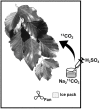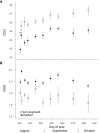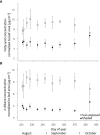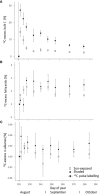Late-season biosynthesis of leaf fatty acids and n-alkanes of a mature beech (Fagus sylvatica) tree traced via 13CO2 pulse-chase labelling and compound-specific isotope analysis
- PMID: 36684794
- PMCID: PMC9853289
- DOI: 10.3389/fpls.2022.1029026
Late-season biosynthesis of leaf fatty acids and n-alkanes of a mature beech (Fagus sylvatica) tree traced via 13CO2 pulse-chase labelling and compound-specific isotope analysis
Abstract
Leaf cuticular waxes play an important role in reducing evapotranspiration via diffusion. However, the ability of mature trees to regulate the biosynthesis of waxes to changing conditions (e.g., drought, light exposition) remain an open question, especially during the late growing season. This holds also true for one of the most widely distributed trees in Central Europe, the European beech tree (Fagus sylvatica L.). In order to investigate the ongoing formation of wax constituents like alkanes and fatty acids, we conducted a 13CO2 pulse-chase labelling experiment on sun-exposed and shaded branches of a mature beech tree during the late summer 2018. The 13C-label was traced via compound-specific δ13C isotope analysis of n-alkanes and fatty acids to determine the de-novo biosynthesis within these compound classes. We did not observe a significant change in lipid concentrations during the late growing season, but we found higher n-alkane concentrations in sun-exposed compared to shaded leaves in August and September. The n-alkane and fatty acid composition showed ongoing modifications during the late growing season. Together with the uptake and following subsequent decrease of the 13C-label, this suggests ongoing de-novo biosynthesis, especially of fatty acids in European beech leaves. Moreover, there is a high variability in the 13C-label among individual branches and between sun-exposed and shaded leaves. At the same time, sun-exposed leaves invest more of the assimilated C into secondary metabolites such as lipids than shaded leaves. This indicates that the investigated mature beech tree could adjust its lipid production and composition in order to acclimate to changes in microclimates within the tree crown and during the investigated period.
Keywords: 13CO2 labelling; Fagus sylvatica; compound-specific isotope analysis (CSIA); cuticular leaf waxes; fatty acids; n-alkanes.
Copyright © 2023 Speckert, Petibon and Wiesenberg.
Conflict of interest statement
The authors declare that the research was conducted in the absence of any commercial or financial relationships that could be construed as a potential conflict of interest.
Figures







References
-
- Ardenghi N., Mulch A., Pross J., Niedermeyer E. M. (2017). Leaf wax n-alkane extraction: An optimised procedure. Org. Geochem. 113, 283–292. doi: 10.1016/j.orggeochem.2017.08.012 - DOI
-
- Ballentine D. C., Macko S. A., Turekian V. C. (1998). Variability of stable carbon isotopic compositions in individual fatty acids from combustion of C4 and C3plants: Implications for biomass burning. Chem. Geol. 152, 151–161. doi: 10.1016/S0009-2541(98)00103-X - DOI
LinkOut - more resources
Full Text Sources

